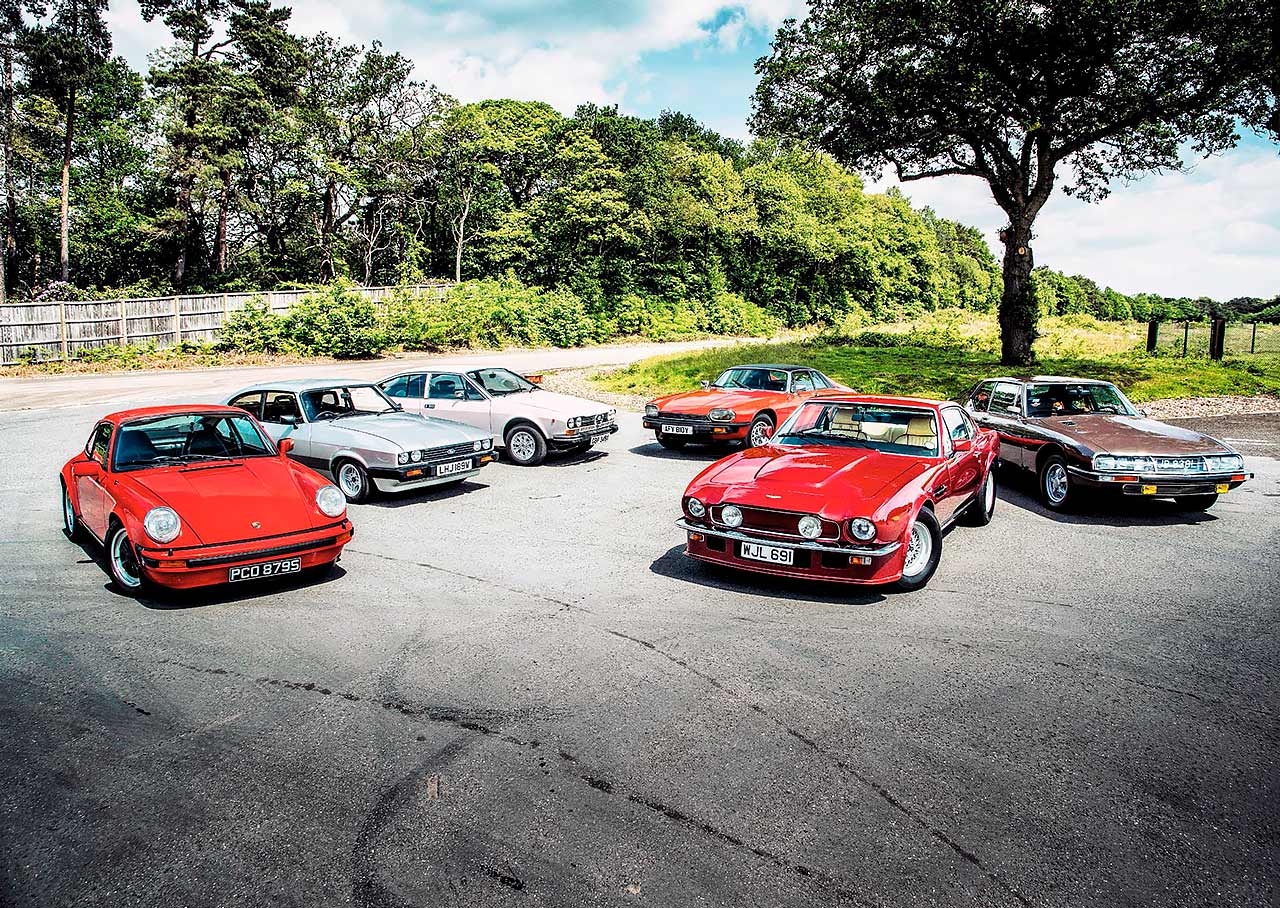
Fast, suave, smart picks from £6-140k. ’70s Grand Tourers. The Ultimate Seventies GT Which of these groovy grand tourers would best banish your budget-airline nightmares forever – the Porsche 911 SC, Ford Capri 3.0S, Alfetta GTV, Jaguar XJ-S V12, Aston V8 Vantage or Citroën SM 2.7 Manual? We drive and rate them all. Their flashing headlights cleared rattly Cortinas and Vivas from the outside lane before assertively blasting past, en route to some far-off place’. Riviera road-trip aspirations fulfilled by our set of 1970s GTs for every budget. Time for a seventies GT. Laden with continent-spanning glamour yet still at home on today’s roads, the GTs of the Seventies make great classic buys. We find the best across all budgets. Words Sam Dawson. Photography Jonathan Jacob.
Meet our long-legged motley crew: Porsche 911 SC, Ford Capri 3.0S, Alfa-Romeo Alfetta GTV, Jaguar XJ-S, Aston-Martin V8 Vantage and Citroën SM 2.7 IE.
The Seventies was probably the last time that owning a new grand tourer really meant something. Lower drag coefficients, five-speed gearboxes and the stability of wider wheels arrived with the hot hatch revolution of the Eighties, and soon ordinary family cars were capable of sustaining an effortless motorway cruise. But things were markedly different when the likes of the Jaguar XJ-S, Aston Martin V8 Vantage, Citroën SM, Porsche 911 SC, Ford Capri 3.0S and Alfa Romeo Alfetta GTV pounded the highways. These were special cars built for big journeys. Their lashing headlights cleared rattly Cortinas and Vivas from the outside lane before assertively blasting past, en route to some far-of place. Nowadays they promise classic perfection – comfortable yet practical, great to drive, at home on any road and to suit every budget.
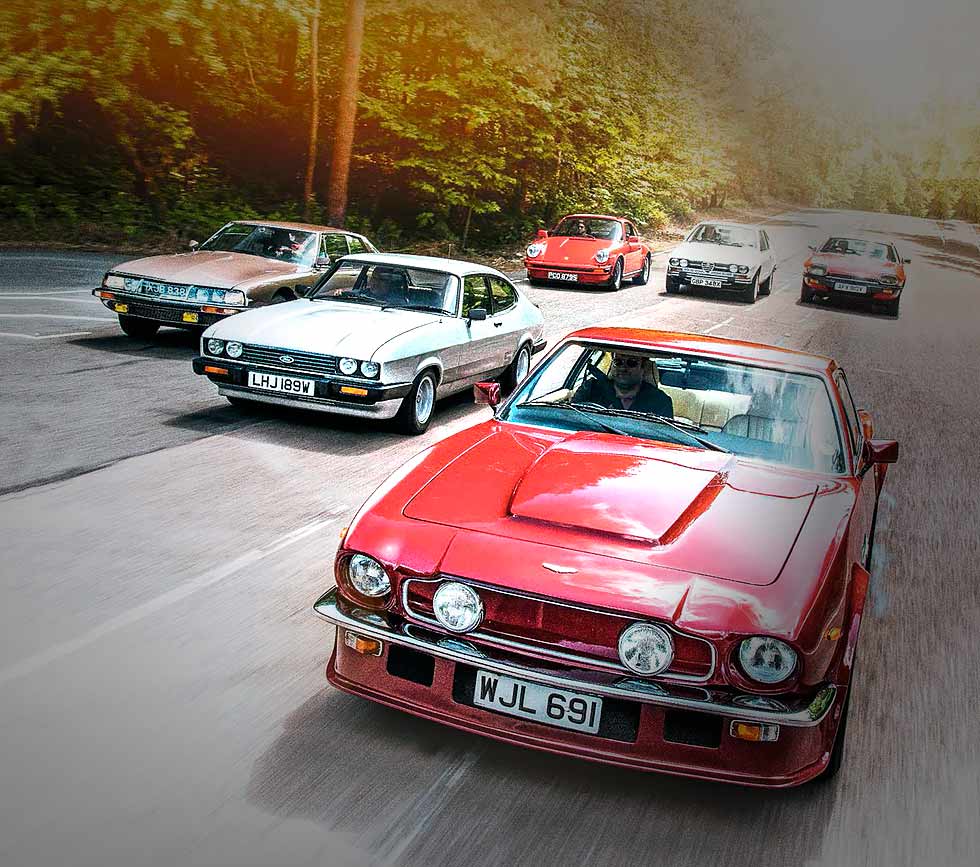
Jaguar XJ-S V12
The Jaguar XJ-S in its pre-High Efficiency guise is the very embodiment of the Seventies luxury GT. Blissfully ignorant of the 1973 oil crisis with its 14mpg proligance, it was a high-tar, full-cream lounge lizard, more than a third of its length taken up with V12-stufed bonnet. It’s a lot of car to contemplate for as little as £3000 for a decent runner.
Climb aboard and even on a hot day its luxury embraces you. Frozen air pours from its interior vents, the driving position is a lazy boxset-binge slouch on deeply-padded quality hide, and the legroom seems endless. Manual XJ-Ss were always criticised for a lack of foot space but this auto feels perfect for two-pedalling.
You look out on a sculpted modernist dashboard, with brushed aluminium taking the place of Jaguar’s traditional planks. It’s all a reminder of Sir William Lyons’ ideas surrounding the car’s creation and summed up in its low, wide stance. It was to be a break with Jaguar’s lagging sports-car tradition, the equal of a Ferrari 400 or Lamborghini Espada thanks to its saloon-sourced V12 engine, yet nearly half the price and easier to live with on account of its standardised, mass-produced nature. And despite its thirst, it still performs this trick today – pre-HE engine bits aside, everything’s available of-the-shelf.
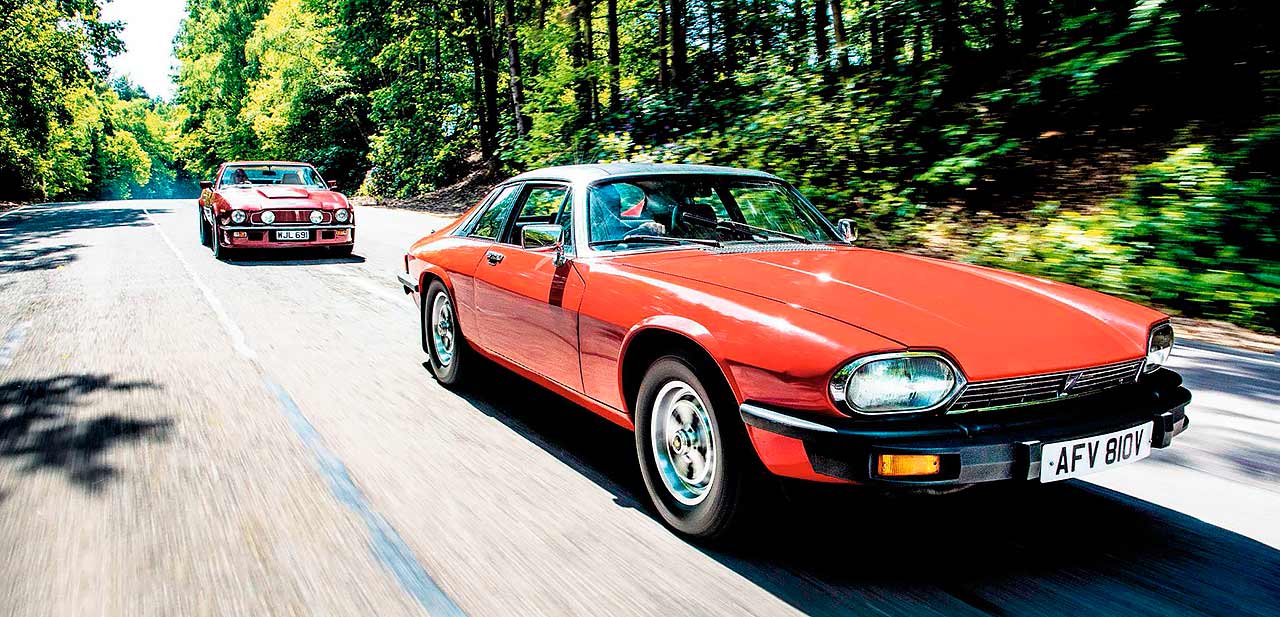
It’s smooth to the point of silence when pulling away, only whirring valvegear reminding you of the 5.3-litre lump the other side of the bulkhead. It’s a similar demeanour to a contemporary Aston Martin V8, funnily enough, but when you try to get yourself into the Aston mindset, British Leyland reality yanks you down to Earth – the dashboard is covered in a leather-look plastic top-roll that makes reappearances elsewhere in the cabin. Still, it looks good even if it’s not the real thing.
The XJ-S is far more interactive and sporting than its reputation suggests. Although it’s best suited to sweeping open roads – it dives alarmingly in sharp bends – its steering is communicative, surface imperfections creeping through the hard, thin, leatherbound rim with a subtle directional shudder. The lack of padding helps – later XJ-Ss had chunky, heavily-insulated wheels and felt numb in comparison. There’s a similar sense of communication in the suspension and the deep-walled 215/70 VR15 tyres too. It does cosset, but potholes and sudden camber changes send a dulled judder straight into the base of the seat.
Accelerate hard and kickdown is almost seamless, although if you hold it in first or second gear the V12 gives of an exotic scream reminiscent of a Ferrari as it hurtles north of 4000rpm. In this accelerative element, the XJ-S manages to be both exciting and relaxing, the act of pulling out on a dual-carriageway to overtake dawdlers feeling like extending the throttles in a private jet. And those twelve perfectly-balanced cylinders make all the difference – it never thumps with torque, it surges on revs, remaining solid and square to the road. The brakes are appropriately powerful too. Design-wise it’s not perfect. Despite being the longest car here it has the shortest cabin – the boot is massive but the rear seats are strictly child-sized. However, the bonnet couldn’t actually be any smaller – the front wings appear shrink-wrapped around the massive V12 and its labyrinthine fuel-injection system.
Decades of low values has left many an XJ-S – particularly the thirsty pre-HE – under-maintained, rusty and full of filler, and although values are climbing steadily a full restoration still isn’t economical. With this in mind, avoid anything with rust in the sills and floors and beware a rotten front crossmember – £4k to ix it puts many in writeoff territory. Engines usually need rebuilding past 100,000 miles too – hot running and dropped valve seats wreck them. However, with even the best still undervalued, good low-mileage cars are still less than £10k, and even half that will get you into this genuine exotica-rival so long as you’re careful.
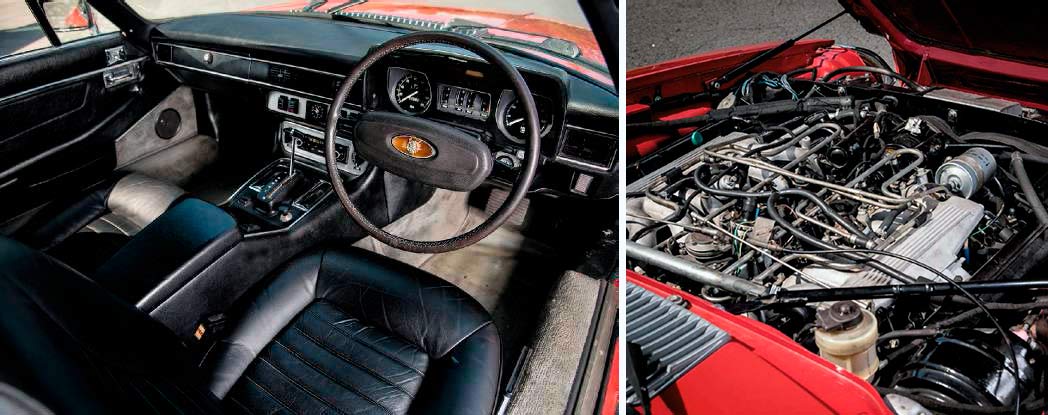
Owning a Jaguar XJ-S
‘It reminds me of a Series 3 XJ my dad had when I was young,’ says XJ-S owner James Powell. ‘I love the ambience of these Seventies BL-era cars – I’ve also got a 1980 Range Rover I’m in the process of restoring.
’I’m a landscape gardener and I spend most of my time driving vans, so the XJ-S is the perfect place to escape to at weekends, sporty yet relaxing. They do have their issues – this restored car was £6000 and it’s a superb example, but it’s still needed new kickdown cables, the speedometer’s temperamental and it threw its viscous fan coupling through its radiator. Pre- and post-HE parts are noninterchangable so much had to be sourced via Japan, but nothing was too expensive.’
‘If you hold it in first or second gear the big V12 gives of an exotic scream reminiscent of a Ferrari’
TECHNICAL DATA FILE SPECIFICATIONS Jaguar XJ-S V12
Engine 5343cc V12, sohc per bank, Lucas/Bosch electronic fuel injection
Power and torque 285bhp @ 5500rpm; 294lb ft @ 3500rpm (DIN)
Transmission Three-speed automatic, rear-wheel drive
Suspension Front: independent, wishbones, coil springs, telescopic dampers, anti-roll bar. Rear: Independent, lower wishbones, driveshafts as upper links, radius arms, twin coil springs and telescopic dampers per side
Steering Rack-and-pinion, power-assisted
Brakes Discs front and rear
Weight 1696kg
Performance Top speed: 155mph; 0-60mph: 6.7sec
Fuel consumption 14mpg
Cost new £9527
Values now £2000-£6500
{module Jaguar XJ-S}
Aston Martin V8 Vantage
The Seventies may have marked the point, so far as the Italians were concerned, where the most desirable cars in the Top Trumps box became cramped, mid-engined and uniformly low in search of speed. Over in Newport Pagnell Aston Martin kept faith with the front-engined four-seater, but that didn’t stop it building a supercar.
The Aston Martin V8 Vantage had more in common with the Maserati Ghibli of a decade earlier, and was based around the hastily-face-lifted architecture of the similarly-aged DBS, but it vied with the mid-engined roadracers for the title of fastest-accelerating car of the Seventies. Nowadays it’s still expensive, but £90k for a well-loved private buy is still only half the price of a Ferrari 512BB or a Lamborghini Countach.
Inside, it’s more superficially luxurious than the XJ-S, with fragrant leather, glossy wood or stainless steel covering every surface. However, when you ire it up, some of the sense of comfort evaporates. After a lengthy starter motor and fuel pump churn, the torque’s throb sets the entire car vibrating even at idle, and early forays to learn the dogleg gearshift pattern reveal a long, wide-spaced, clanking action coupled to pedal actions heavy enough to dislodge bits of Stonehenge.
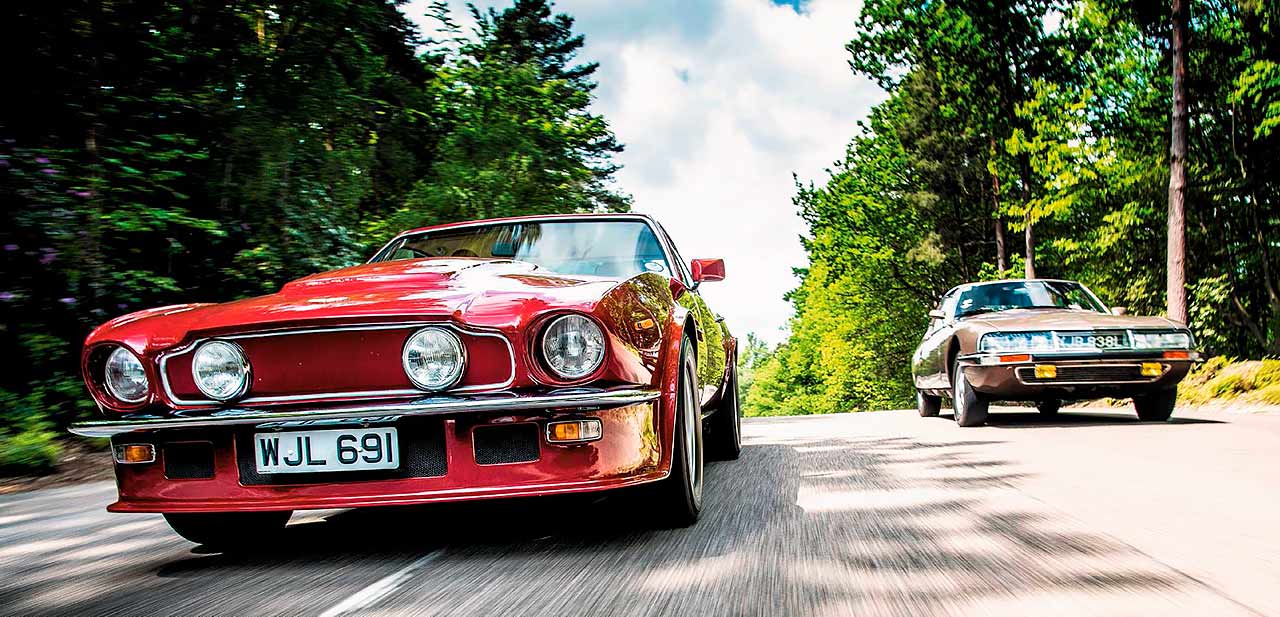
While a drive in the Jaguar XJ-S is as smooth and easygoing as a conversation with an old friend, just sitting in the Vantage at idle feels like preparing for an impending encounter with some table-thumping captain of industry who doesn’t suffer fools gladly. It may be upmarket, well-appointed and steeped in elegant tradition, but it has the power to ruin you. You’d better know what you’re doing.
It thunders of the line, the slightly hesitant nature of the standard V8 on which it’s based vanishing under heavy slabs of relentless downdraught-fed torque. The driving position is commanding – there’s surprisingly little adjustment in the seat, the roof is rather low and the windscreen steeply raked, meaning a reclined posture with limbs thrust straight forward is forced upon me. The steering feels heavy too, so there’s no scope even once up to cruising speed to rest an arm on a door capping or centre console and attempt to steer with one hand. This is Ferrari discipline, and leaves you in no doubt that this is a supercar even if it doesn’t look like one.
You need to be careful with the gears too. While it’s a tractable engine with all this torque and remarkably low-risk so long as it’s properly maintained, you can’t fluff a gearchange or it’ll bog down, waling and harrumphing. In its own solid way, it’s as temperamental as a Daytona. At lower speeds, the Vantage feels secure, the steering meatily precise. It’s a more compact car than the XJ-S and as a result is agile and muscular on our country-lane route, with hints of MG BGT in its stocky, pugilistic demeanour.
But on a long straight in third gear with my right foot planted in the deep-pile carpet, it becomes a true supercar. The rear end squats ever so slightly as the exhausts bellow and the Vantage reels in the asphalt with the kind of thrust that gets Boeing 777s airborne. The Vantage will reach 170mph and happily cruise in excess of 120, but making course-corrections at speeds like this feels increasingly dangerous. Although that front spoiler tries its hardest to keep the nose planted, the heavy-handed solidity the Vantage exhibits at 50mph runs out at higher speeds, the wide front 275/55 R15 Avon radials noticeably wandering and an element of vagueness creeping in at the helm, wobbling around the dead-ahead. You need to ensure you’re tracking as straight as possible before heaving on the double-hinged brake pedal – those anchors are appropriately powerful, but there’s no ABS to bail you out.
But even if it’s forever running the risk of ramming the car in front in stop-start traffic, the Vantage is never anything less than awe-inspiring. That sense of awe, however, also helps when inspecting its structure. With the original steel chassis poorly rustprotected and the threat of electrolytic corrosion where it meets the aluminium body, the only solution is to cut the metal away and fabricate new sections. Sills are a favourite, and bubbling around the scuttle suggests deep-seated decay. While it doesn’t always entail an end-to-end rebuild, sorting those sills properly runs to £10k a side. It may be less bother than a Ferrari when it’s been looked after, but Vantage ownership never has been cheap.
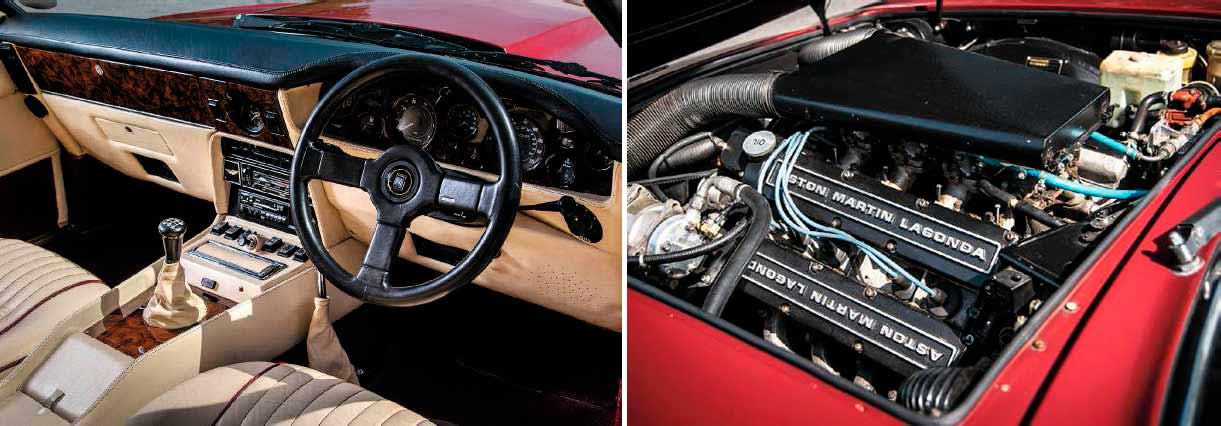
The V8 reels in the asphalt with the kind of thrust that gets Boeing 777s airborne’
Owning an Aston V8 Vantage
‘I had two new Vantages a year in period, and still swear by them today,’ says Aston Martin specialist and serial Vantage owner Roger Bennington of the Stratton Motor Company.
‘They’re capable of huge mileages without giving trouble – in 200,000 miles I only had one fuel pump fail and even then it still limped home. I’d routinely drive to Monaco and Geneva in one hit without feeling achey.
‘One design fault is the air conditioning – the matrix is right next to the heater which causes the screen to mist up badly, but it’s fine if you don’t iddle with the temperature and just wind the window down to let the air out.
‘Their weak spots are the sills – many were bodged but they really need their doors of and lower body cutting away. A full body-of restoration is £250k but it’ll last well.’
TECHNICAL DATA FILE SPECIFICATIONS Aston Martin V8 Vantage
Engine 5340cc V8, dohc per bank, four Weber 48 IDF carburettors
Power and torque 475bhp @ 6000rpm; 440lb ft @ 5000rpm (DIN)
Transmission Five-speed manual, rear-wheel drive
Suspension Front: independent, unequal-length double wishbones, coil springs, telescopic dampers, anti-roll bar; Rear: de Dion axle, trailing arms, Watt linkage, coil springs, telescopic dampers
Steering Rack and pinion, power-assisted
Brakes Discs front and rear
Weight 1814kg
Performance Top speed: 170mph; 0-60-mph: 5.2sec
Fuel consumption 14mpg
Cost new £23,000
Values now £90,000-£185,000
{module Aston Martin DBS / V8}
Citroën SM 2.7 IE
Most luxury GT interiors are full of things you wouldn’t dare put in your house. Colossal white leather armchairs with high-contrast piping, wood-veneer panels with a treacly gloss finish and pale deep-pile carpets all spring to mind. But thankfully, the Citroën SM is defiantly different.
Bronze brushed-alloy facings, soaring plastic mouldings, continuous-radius tobaccobrown seats that are as comfortable to sit in as they are intriguing to look at – it’s all beautifully thought-out in isolation as well as in situ. Even the dashboard switches are pretty things all angled to resemble miniature versions of the handbrake lever, and the switches for bass and treble on the vertically-mounted radio aren’t signified by the words, but the musical clefs.
If you disassembled this interior and scattered its constituent parts around the living room of an open-plan Eero Aarnio-designed modernist villa, it’d still look perfect. And with the market in a state of confusion over values – is it a Citroën or a Maserati? – it’s a good time to find a £25k bargain before everyone else notices. The most satisfying design feature is the SM’s rolling-cylinder gear gate, even more stylishly industrial than a Ferrari’s slotted chrome plate, beautifully damped and positive in action. Pull away, and although the feisty snarl of the Maserati V6 up front is encouraging, it’s the prospect of selecting another gear that partly spurs your progress. In some ways, the SM is the car the great Citroen DS always should have been, with a thoroughbred V6 instead of the clattery old Traction Avant-derived four-cylinder engine – although with this added complexity comes greater potential expense and historical neglect.
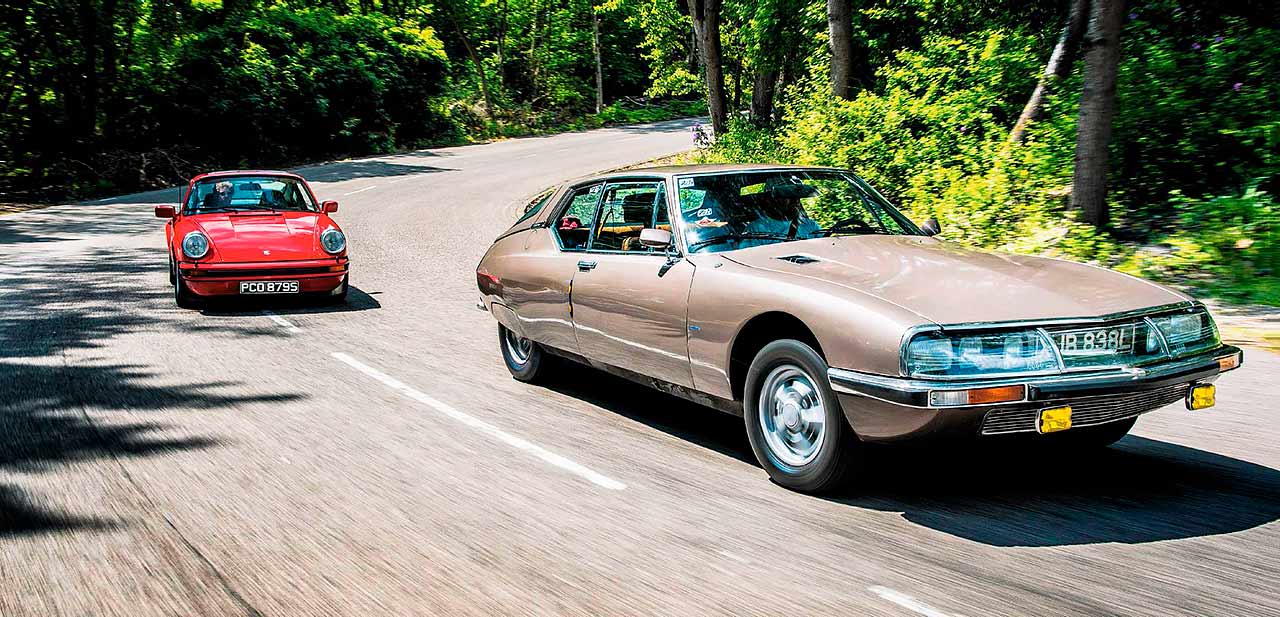
It’s practical though, its long doors allowing good access to deeply-scooped rear seats, its huge boot covered by a vast hatch. But Citroën didn’t forget to make it a driver’s car, as any great GT should be. A clue lies in its unusual resin wheels. Derived from Citroën’s successful rally programme of the Sixties, they weigh just four kilograms each as opposed to the 12kg of a conventional steel wheel, reducing unsprung weight.
The front-wheel-drive layout actually pays similar dividends – there’s no heavy propshaft to accommodate, helping the second-smallest powerplant of our gathering to make the SM as fast as the Jaguar with half its displacement and cylinders. The narrowed rear track, glazed bullet-nose, boarded-up rear wheels and Kamm-style tail help to reduce aerodynamic drag to 0.339 Cd. The mainstream took until the late Eighties to catch up.
It rides as serenely as you’d expect on those oleopneumatic spheres, managing to make even the Jaguar seem a bit unrefined in the way it soaks up tarmac ripples, and even rough-edged potholes are softened to slight undulations by the time they reach the cabin. Unfortunately, they’re also responsible for the SM’s only real handling foible.
Turn in hard on a tight, low-speed bend and the sudden forces at work quickly override the smooth-acting technology’s refinement, causing the body to roll so hard you worry about bottoming a sill out on the road. It’s especially noticeable if sharp braking is involved in the manoeuvre, anything other than a soft squeeze of the floor button threatening to stand the SM on its nose.
Ultimately though, it’s a foible you quickly learn to drive around, and on the wide, high-speed roads to which GTs are best suited the low-speed lurch gives way to self-levelled smoothness. Most impressively, the SM feels thoroughly modern. Not just forward-looking, but genuinely ahead of its time. Its spaciousness, wide front footprint, embrace of front-wheel drive, secure roadholding and servo-assistance of nearly all its controls to enhance rather than detract from the driving experience – plus thumping torque from a compact powerplant – previewed modern coupés from mainstream manufacturers.
However, modern platform-engineered coupés still have a lot to learn from the SM. They’re nowhere near as stylish, especially inside, and in an era of sound synthesisers piping engine noise through stereo speakers, no front-drive engine has the charisma of the SM’s snorting 2.7-litre Maserati V6.
Patchy maintenance bedevils SMs and has led to wildly variable values as a result. Make sure the hydropneumatic system has been looked after by a respected marque specialist, and that everything works because it’s all interlinked. Likewise, ensure the V6 has been fettled by a Maserati mechanic – its various chains and tensioners need checking at least every 6000 miles, its sodiumilled valve tips rust and break, and the oil-cooling system is leakprone – all of which can trigger a need for a £15k engine rebuild. Independent inspection is crucial, whether you’re buying a £25k driveway punt or a £60k dealership concours-contender.
‘The SM feels thoroughly modern. Not just forwardlooking, but genuinely ahead of its time’
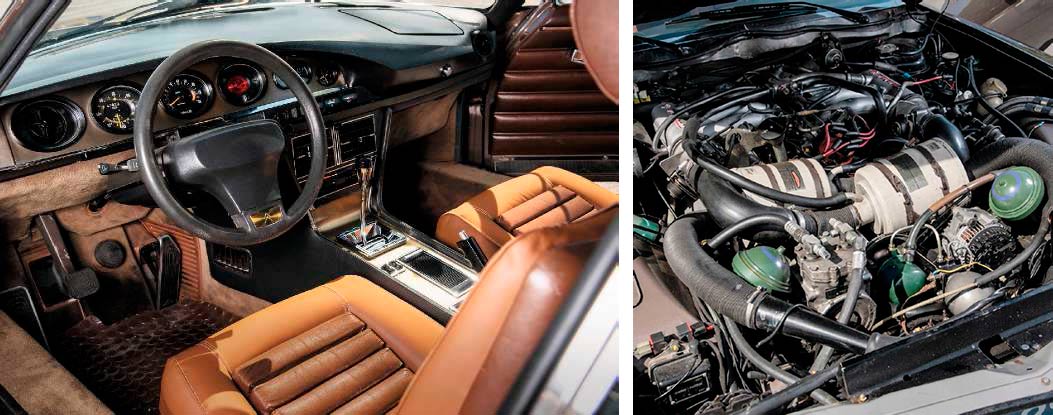
Owning a Citroën SM
‘You may have noticed the Giugiaro badges on its front wings,’ says SM owner Simon Wolfe. ‘Well, I drove this car to a Citroën-Maserati event in Italy, where I met Fabrizio Giugiaro, son of Giorgetto and also a car designer. He gave me these badges – it turns out the SM was the first design he worked on, as an understudy to Robert Opron.
‘You have to keep on top of the maintenance, especially of the Maserati engine, but once the hydropneumatic system is wellsorted it doesn’t give trouble. I’ve covered huge distances in this.
‘However, most don’t handle properly, because the suspension was set up for the resin wheels but most don’t have them. I sourced these ones in France – they cost me £4000 each!’
TECHNICAL DATA FILE SPECIFICATIONS Citroën SM
Engine 2670-2965cc Maserati V6, dohc per bank, Bosch electronic fuel injection (Electronic Injection Bosch D-Jetronic) or three Weber 42 DNCF carburettors on 2.7 and 3.0 models (US-spec)
Power and torque 170/178/180bhp @ 5500rpm-6000rpm; 170-188lb ft @ 4000-4400rpm (DIN)
Transmission Five-speed manual or 3-speed automatic Borg Warner, front-wheel drive
Suspension Front: independent, double wishbones, hydropneumatic self-levelling spheres. Rear: independent, trailing arms, hydropneumatic self-levelling spheres
Steering Rack and pinion, power-assisted
Brakes Discs front and rear power-assisted by hydraulic system
Weight 1449-1490kg
Performance Top speed: 137mph; 0-60mph: 8.2sec
Fuel consumption 22mpg
Cost new £6498
Values now £22,500-£60,000
{module Citroen SM}
Porsche 911 3.0SC
Yes, I know, we’ll get letters. This is a celebration of Seventies GTs, and rather than include one of the decade’s most distinctive grand tourers, the Porsche 928, we champion the model with its roots in the Sixties that the 928 was supposed to replace instead, the Porsche 911 SC.
But there are very good reasons. Great though the 928 was – and clever too, with its passive rear-steering axle and adjustable-rake instrument cluster – it followed rather than led. It may have been a space-age take on the traditional GT, but with its big V8 and rear-wheel drive, traditional is what it was, and Porsche didn’t profit from it either.
But the 911 led as a uniquely sporting compact two-plus-two GT. Its success, balancing unique usability with genuine race-winning prowess, spawned an entire genre of rivals in the Seventies with the likes of the Dino 308 GT4, Lamborghini Urraco, Maserati Merak and Alpine A310. And just when it seemed the Italian and French opposition was gaining a foothold, Porsche raised the stakes again with the 3.0 SC, the ‘Super Carrera’.
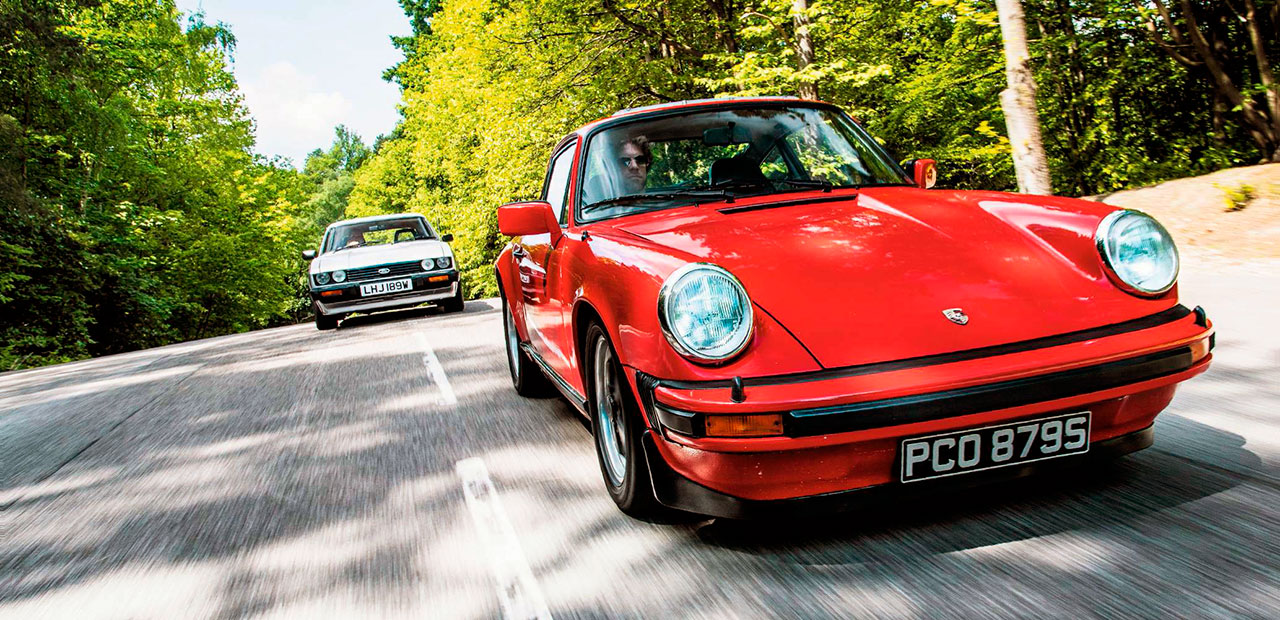
With subtly wider bodywork allowing for grippier rubber, plus a hot-dip galvanised bodyshell and a deliberately low compression ratio of 8.5:1 to ensure it could run on regular pump petrol anywhere in the world, the SC took the concept of sports-car usability to levels its rivals couldn’t match. It’s a role the 911’s descendants still fulfil today, helping to make Porsche the most profitable car firm in the world. Nowadays with Sixties cars and motor sport variants attracting all the attention, the SC is a cheap way into an aircooled 911. Scruffy ones are under £20k.
Popular it may be, but gauging the driving position in an aircooled 911 is still an odd activity because it revolves around the floor-hinged pedals, which are more easily pressed with a flexed ankle and straight legs; but the close, upright windscreen forces the wheel closer to you than the shallow leather-clad dashboard would lead you to believe. It might be compact compared to the other cars here, but it’s also pleasingly snug, an intimate companion for a long-distance drive.
Nothing pulls away like a 911. With the engine warbling away at the rear, there’s no threat of wheelspin and so long as you’re going in a straight line you can put a lot of power down almost immediately. Once you get used to this, you can transpose the theory to corner exits too, and the search for the point in each bend when the power can be applied becomes an entertaining travel game to play on motorway-avoiding long-distance jaunts.
However, it’s a risky pastime – pick that point too early in the turn and there’s every chance you’ll end up hurtling backwards. Also, the rear-mounted engine makes high-speed braking a fraught process. While a hard-stopping front-engined GT will drag its nose forward into understeer, a 911 in the same scenario is trying to hurl its rear-sited mass past the cockpit. Even in a straight line the SC squirms from side to side under braking from 100mph. That said, providing the torsion-bar suspension has been correctly set-up, it gets the balance of sports car and GT just right. The relatively high sidewalls of its tyres – 205/55 R16 front, 225/50 R16 rear – serve to isolate your spine from the jiggly communication of its firm suspension, and while the steering wheel hums with constant feedback as to what’s going on under the front wheels, it doesn’t jar or numb your fingers. If it’s hardriding and clanks, a suspension rebuild will be at least £1200.
The SC’s Italian rivals proved impractical and temperamental in the real world. Such things don’t trouble sports-car purists, but this is why the 911 SC is successful as a GT as well – Porsche caters to casual owners as much as it does for aspiring racers. This means there are plenty to choose from, but also many uncared-for examples around too. The 3-litre engine had a habit of snapping its cylinder head studs and demolishing its rubber-centred clutch assembly – both £4k-£5k to put right. Although galvanised, hidden rust takes hold in the B-posts and scuttles. Upwards of £20k they’re still a relative bargain, but below £17k it’ll be a potentially expensive project car. But in any state, it’s still just a fifth of the price of the remarkably similar £100k-plus Carrera 2.7.
‘Certain parts are very hard to find now so I’m glad no-one took them of my car’
‘Finding points in bends where the power can be applied becomes an entertaining travel game’
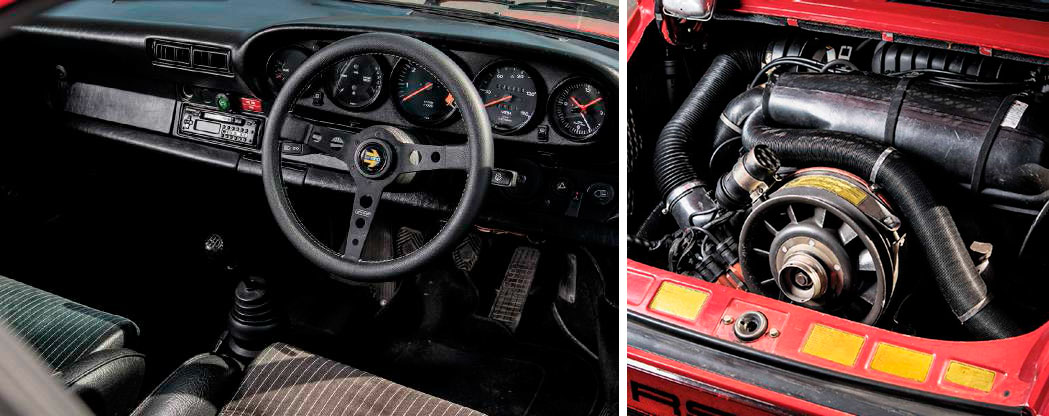
Owning a Porsche 911 SC
’It’s increasingly hard to find nice 3.0 SCs – so many ended up being visually updated in the Eighties with whale-tail Turbo spoilers and front splitters, then for years no-one wanted them because the Carrera 3.2 was considered the better car,’ says owner Luke Newland.
‘I’ve had to it a smaller steering wheel – a period option item – because I’m long-legged and the original item is huge and restricts kneeroom. Certain parts, like the chrome headlamp rings and the early periscope-shaped headlamp washers, are very hard to find now so I’m glad no-one took them of my car!
‘It rides better than later 911s, so it’s preferable for long drives and it’ll sit at 100mph all day long. But it’s still every inch a 911 – the noise it makes is unmistakable.’
TECHNICAL DATA FILE SPECIFICATIONS Porsche 911 3.0 SC (G-Series)
Engine 2994cc horizontally-opposed six-cylinder, sohc per bank, Bosch K-Jetronic fuel injection
Power and torque 185bhp @ 5500rpm; 195lb ft @ 4200rpm (DIN)
Transmission Five-speed manual, rear-wheel drive
Suspension Front: independent, MacPherson struts, lower arms, torsion bars, telescopic dampers, anti-roll bar; Rear: independent, semi-trailing arms, torsion bars, telescopic dampers, anti-roll bar
Steering Rack and pinion
Brakes Discs front and rear
Weight 1243kg
Performance Top speed: 140mph; 0-60mph: 7sec
Fuel consumption 22mpg
Cost new £12,600
Values now £17,500-£37,500
{module Porsche 930}
Ford Capri 3.0S
Essex seafront boulevards. Boy-racers. ‘The car you always promised yourself.’ The Ford Capri was the Seventies grand tourer everyone could afford to the point where it was regularly found in the UK’s top ten bestsellers list. But in this company surely that makes it a bit, well, underwhelming? In the way the Ford starring Professionals was a grittier, more domestic, less glamorous take on the transcontinental crime busting capers the Aston and Citroën enjoyed in The Persuaders and The Protectors; the Capri was surely a Cortina pretending to be a Jensen Interceptor?
Perhaps not. The 3.0S is an icon and values are rocketing – you won’t find a crumbly one for a few hundred quid any more. Seeing this mint-condition, unmolested example here after years of rusty attrition demonstrates why. There’s an industrial starkness to its lines, much-simplified compared to the chintzy MkI with its dummy brake vents. The combination of cold silver paint and simple matt-black grille, strobe-stripe decals and rubber rear spoiler hint at the sober-yet-slick direction German car design would take in the Eighties. If you’d never seen one before, debadged it would’ve passed muster as an Audi or BMW.
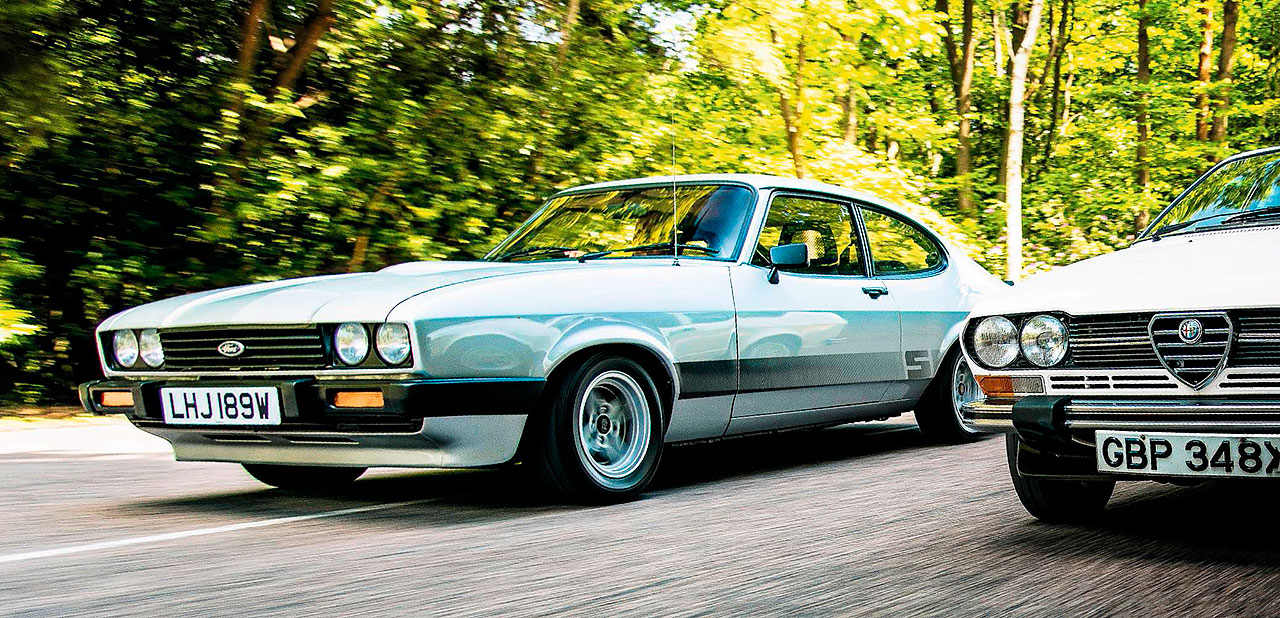
It’s clearly a Ford inside, although with today’s trim-sourcing issues it’s rare to find them in all their original Seventies glory – black, synthetic and with that distinctive whiff of skin-searing vinyl familiar to anyone who took a family summer holiday before 1989. But as with the best Fords, the driving position confirms the way the company’s engineers concentrated on the fundamentals: highly adjustable and ultimately controlling, with good legroom, well-spaced pedals and a short-travel gearstick a handily short reach from the wheelrim.
The 3.0-litre ‘Essex’ V6 pulls away cleanly and remarkably smoothly with a satisfying tow of sub-1000rpm torque, making a pleasing growl that speaks of its potential but avoids rattling the fixtures and fittings. Although relatively basic, it actually feels better made than the XJ-S, which although well-appointed was assembled with all the care and attention of a sandcastle.
Once up to speed the Capri surprises with sophistication thanks to its S-spec suspension. It’s stiffer than the roly-poly Ghia, underlining how buyer-dependent Capris were, but its coil and leaf springs and telescopic dampers are actually more progressive and less choppy than the torsion bar-suspended Porsche’s. Coupled with the predictability engendered by the traditional front-engined rear-drive layout, there’s a surgical precision to the Capri’s steering on turn-in and it remains almost flat and neutral throughout the bend. Much has been said about Ford’s marketing, tapping into the GT dream, but in reality the 3.0S drove more like a real Aston V8 than most Capri owners would have ever known.
Yes, there’s oversteer available if you really are seized with an urge to knock down some cardboard boxes, but despite the Capri’s reputation it’s actually at its most satisfying when it’s on its best behaviour, sustaining an unruled high-speed cruise on a consistent wave of torque and swiping its way through sweepers and hairpins alike with ease. Granted, the seats don’t breathe very well and there’s no air conditioning even as an option, but nothing in its price bracket back then had it. What its mass-market rivals were really missing was the V6. Big engines tended to turn up in wallowy luxobarges and their enamel-badged ‘personal coupé’ siblings like the Vauxhall Royale, but if you wanted six cylinders squeezed into a Manta you had to ask Transeurop Engineering to do it for you. Ford’s small, fine-handling sub-£5000 coupé with its engine bigger than a Citroën SM’s was unique in Europe.
TV-star appeal and relative rarity compared to the coarser 2.8 Injection puts the 3.0S in its own market, where £15k-plus values for concours cars make them worth restoring, but also the preserve of wealthy Bodie & Doyle fans. They’re well-guarded and hard to find. If you do track down a privately-sold £5k car it’ll be subject to the usual Capri issues – extensive rust and unobtainable trim. The Essex V6 also suffers from weak oil pumps and timing gear – make sure they’ve been upgraded or risk a £1600 bill. That said, these are ultimately simple mass-produced cars, which helps make life easier in the classic world.
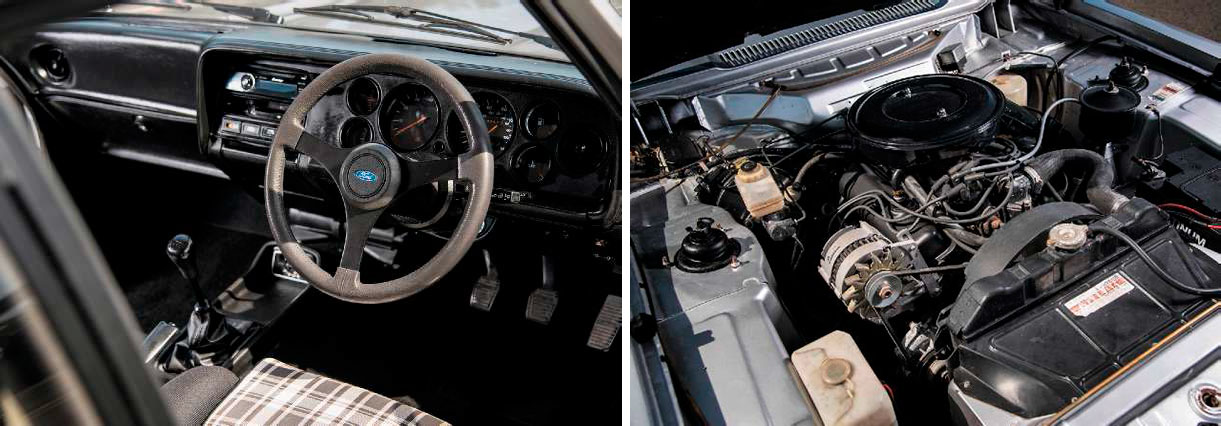
‘There’s oversteer available if you really are seized with an urge to knock down some cardboard boxes’
Owning a Ford Capri 3.0S
‘Genuine 3.0S Capris are very hard to find nowadays,’ says Ford owner Joe English. ‘The MkIIIs were only made for very long – 1978-1982 – and they suffered in comparison to the 2.8 Injection so people didn’t bother saving them, or tended to modify them. However, I’m a huge fan of The Professionals, so when the chance came up to buy a silver one just like Lewis Collins’ car, I had to have it. I’ve restored it to mint original condition, but as parts are so scarce now I don’t want to risk damaging it so it only gets used sparingly – shows, concours, the occasional run out. Instead I built my own Capri ‘special,’ with a 2.8 Cologne engine converted to carburettors, as my daily driver.
‘The Professionals has certainly affected values. Collectors who remember the series want them now, and they won’t necessarily be hardcore classic Ford enthusiasts either.’
TECHNICAL DATA FILE SPECIFICATIONS Ford Capri 3.0S
Engine 2994cc V6, ohv, Weber 36 DGAV carburettor
Power and torque 138bhp @ 5000rpm; 174lb ft @ 3000rpm (DIN)
Transmission Four-speed manual, rear-wheel drive
Suspension Front: independent, MacPherson struts, lower links, coil springs, telescopic dampers, anti-roll bar. Rear: Live axle, semi-elliptic leaf springs, telescopic dampers, antiroll bar
Steering Rack and pinion, power-assisted
Brakes Discs front, drums rear
Weight 1168kg
Performance Top speed: 119mph; 0-60mph: 8.6sec
Fuel consumption 20mpg
Cost new £4593
Values now £5000-£15,000
{module Ford Capri}
Alfa Romeo Alfetta GTV
This feature may seem to be a feast of big engines, but the oil crisis of 1973 dominated the Seventies motoring landscape. Although the wealthy traditionalists who bought XJ-Ss and V8 Vantages didn’t really notice, the middle classes were feeling the pinch at the pumps. Thankfully, this squeeze prompted a very different kind of grand tourer, designed with fuel economy in mind yet without compromising on performance or driving fun.
Alfa Romeo had a head start. The Alfetta GTV built upon the foundations laid by the Giulia GT in its various guises. Like the Giulia it derived its performance from the clever twin-cam valvegear attached to the all-alloy two-litre four-cylinder engine. But Giorgetto Giugiaro clad the transaxle-gearbox Alfetta platform in a 0.36 Cd body that promised to accommodate four adults and plenty of luggage within its three-door fastback form. They’re also very undervalued with runners to be had from £3k, but is it worth putting up with their notorious fragility to enjoy their charms?
It’s easy to find yourself falling in love with the GTV’s elegance. There’s the subtlest of spoilers worked into the bootlid, in turn lending the car very slight rear buttresses alongside the recessed hatch, and the chrome-bumpered nose is reminiscent of the Montreal’s. The interior entices with minimal dark-wood veneer and a pair of square binnacles looking like a Seventies executive desk tidy, speedometer separated from tachometer, temperature, oil pressure and fuel gauge and placed in the driver’s line of sight. On this hot day the Alfa’s seats are the only ones in this company to feel cool. They’re beautifully soft velour rather than leather, perfect for toughing out a traffic jam on a baking autostrada. Unfortunately the driving position doesn’t suit the long-legged.
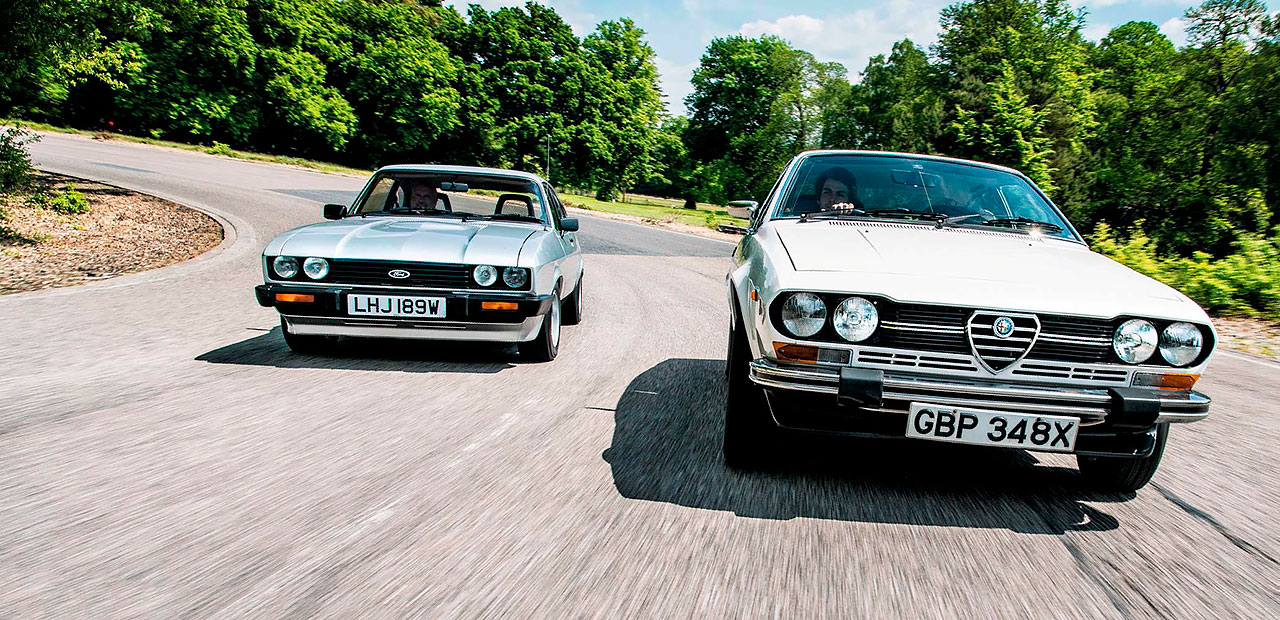
The vast steering wheel ends up between my splayed knees, and it doesn’t take many miles to realise that the steering itself is unexpectedly long-winded and lacks feedback. It’s a noisy car too – there’s a strange ratcheting sound when you press the clutch pedal to engage first gear, and the revs rise angrily as it bites. Thing is though, it’s a wonderful noise, a peaky blare of the sort you’d expect from a Sixties Formula Three car. It’s also worth pointing out that you’d encounter similar acoustic issues in the Jensen GT, Porsche 924 Turbo and Lotus Éclat, which at over £10,000 in 1978 were twice the Alfa’s price. Nowadays things have equalised but for a high-mileage but cherished example, they’re still well under £10k today.
It’s when you realise that the Alfetta GTV was the same price as the Capri 3.0S that its laws seem less severe. It’s only 15bhp down yet achieves the same performance figures from a whole 1000cc less. With kerbweight of less than 1000kg, it was actually lighter than the Lotus. And then there’s its chassis engineering.
Although the Alfa’s steering will always disappoint and its longthrow gearbox remains divisive, cornering hard is a joy because the chassis balance is so exquisite. The lightweight alloy engine is neatly balanced by the rear-mounted gearbox, something most clearly noticed when you push the car into a mild drift, use the vague steering to point it in the general direction you’d like it to go in, then use the accelerator to shift the weight back and forth between the mass centres of the engine and transaxle. It’s a similar technique to cornering an Audi quattro, but the Alfa is neat and delicate, rather than heavy-handed and brutish.
Sadly, the reason why you probably haven’t seen an early GTV on the road in years is down to our climate. Later plastic-bumpered Eighties models were better-rustproofed and survive in greater numbers but you’ll pay for Seventies chrome-bumpered purity – this mint-condition car is currently up for an entirely understandable £12,950. Restoring a rust-ravaged example to this standard wouldn’t make sense, which is why it might be a better bet to source one from Southern Europe or even a right-hand-drive example from South Africa via a specialist importer. You’ll pay £10k-plus, but avoid expensive bodywork-related bills. If you’re looking at a UK car, beware rust in the sills, wheelarches, boot and cockpit floor, all hidden by filler and soggy carpets. Find a good one and cherish it – its time will come.
‘It’s only 15bhp down on the Capri yet achieves the same performance figures from a whole 1000cc less’

Owning an Alfetta GTV
‘The early cars are hideous rotters, even by the standards of the Seventies,’ says ‘transaxle’ Alfa specialist Alex Jupe, who ran GTVs as daily-drivers for 15 years, covering 250,000 miles. ‘The bodyshells weren’t primed, seam-sealed or rustproofed and you can’t buy repair panels, so everything has to be handmade nowadays. If you buy an Alfetta GTV that turns out to be full of filler, it could end up costing between £15,000 and £30,000 to put right.
‘Because of this, it’s actually increasingly common for owners to customise them with parts from later GTV6s and 75 saloons. The suspension on these early GTVs is much better, but the gearbox is very vague and they drive better with one from a 75. The velour seats wear out fast too, so you’ll often find them fitted with leather items from a GTV6.
‘Over my time with GTVs, the only problems encountered in regular running were electrical, because of their open connectors corroding, but the mechanical parts are very reliable if properly maintained. But if they were subjected to daily use the rot always got them in the end. If you buy one, treat it with Dinitrol as soon as possible!’
TECHNICAL DATA FILE SPECIFICATIONS Alfa Romeo Alfetta GTV
Engine 1962cc in-line four-cylinder, dohc, two Dell’Orto 40 DHLA carburettors
Power and torque 122bhp @ 5300rpm; 129lb ft @ 4400rpm (DIN)
Transmission Five-speed manual, rear-wheel drive
Suspension Front: independent, double wishbones, torsion bars, telescopic dampers, antiroll bar; Rear: de Dion axle, Watt linkage, coil springs, telescopic dampers, anti-roll bar
Steering Rack and pinion
Brakes Discs front and rear
Weight 998kg
Performance Top speed: 118mph; 0-60mph: 8.9sec
Fuel consumption 24mpg
Cost new £4799
Values now £3000-£10,000
{module Alfa Romeo Alfetta GTV Club}
Verdict
All of these cars are special, and that feeling stems from the Seventies. The increasing competence of ordinary Eighties family cars rendered special GTs increasingly irrelevant, but so did Freddie Laker and Niki Lauda – as air travel became more affordable, owning a car specifically to take long cross-continental drives became less important.
Nowadays Ryanair fuels more stand-up comedians’ routines than globetrotting dreams, and airports are places where you queue to take your shoes off and have your bags searched. Taking any one of these cars for a long trip starts to look more like a holiday.
And it’s for this reason that the Citroen SM wins. It rides, cruises and accommodates better than any other challenger. It’s less intimidating than the Aston, less thirsty than the Jag, and in a world of front-drive ubiquity it’s as accessible as the Alfa. It’s also as easy to admire from the inside as well.
However, an honourable mention must also go to Ford. By concentrating on design and engineering fundamentals, it made the Capri 3.0S as good a GT as many more exotic cars. A European Mustang? No, it handled better than that. It was the working man’s Iso Grifo.
Thanks to: Roger Bennington, Stratton Motor Company (strattonmotorcompany.com); Edward Hall (edward-hall.co.uk), who is selling the Alfa Romeo for £12,950.
‘Today, budget airline woes make these miledevouring classics seem even more relevant now than when they were new’
Willson’s favourite 1970s CT
I grew up in the Seventies watching swish GTs driven by loaded businessmen (as we called them then) barreling down the outside lane of the M1. Most were bought with company money but, like their portly director owners, spent too much time in the golf club car park. If I were buying one of these relics of Britain’s spoilt entrepreneurial classes I wouldn’t go for the Alfetta – not sexy enough. And while the V6 Capri is surprisingly quick and competent, I think prices have overheated.
For me it’s a tough choice between the Citroen, Aston, Jag or Porker. SM prices are all over the place and cheap cars do come up regularly. I’ve seen good ones sell for £25k. Any V8 Aston is worth buying at £70- £80k as they’re incredible value compared to the DB cars. The Porsche 911 SC is a wise and charismatic buy at £35k but the one that has highest long-term potential is a ‘1975-1976 XJ-S manual. There’s one on Classic Cars for Sale right now – April ‘1976, Signal Red, 70k and only £18k. With only a couple of hundred ever built and few survivors, an early manual XJ-S would be my choice.
Exquisite chassis balance makes hard cornering a joy in the Alfetta GTV. S-spec suspension and ample 3-litre grunt make this Capri a consummate grand tourer. Aston V8 Vantage is precise through corners and a true supercar on a long straight. Maserati V6 makes the SM a fine long-distance cruiser once you’ve mastered its body roll. The 911 allows acceleration out of corners earlier than the others. Jaguar XJ-S is longer than the Aston but all that bulk houses an appealingly agile personality. Which of these magnificent six will Sam Dawson most want to take home?
{CONTENTPOLL [“id”: 113]}





